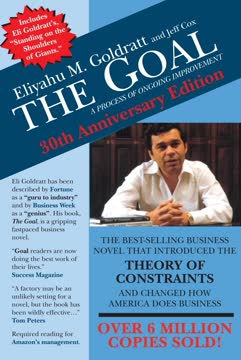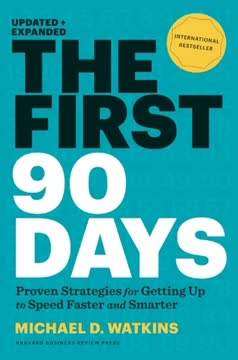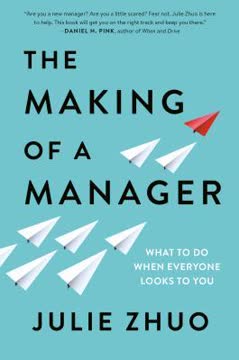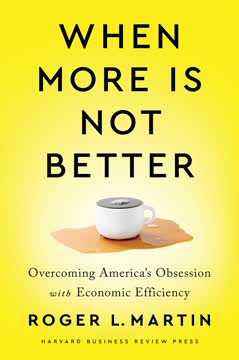نکات کلیدی
1. تفکر طراحی تعادل بین قابلیت اطمینان و اعتبار را برای نوآوری پایدار برقرار میکند
تفکر طراحی نوعی از تفکر است که حرکت در مسیر دانش را ممکن میسازد و شرکتهایی که در این زمینه تسلط پیدا میکنند، مزیت تجاری تقریباً نامحدود و بلندمدتی به دست خواهند آورد.
عمل متعادل. تفکر طراحی تنش بین قابلیت اطمینان (نتایج ثابت و قابل پیشبینی) و اعتبار (تولید نتایج مطلوب) را reconciles میکند. در حالی که قابلیت اطمینان بر بهبود فرآیندهای موجود تمرکز دارد، اعتبار به دنبال راهحلهای جدید برای مشکلات پیچیده است.
مزیت رقابتی. شرکتهایی که بهخوبی این رویکردها را متعادل میکنند، مزیت پایداری به دست میآورند. آنها میتوانند بهطور مؤثر از دانش فعلی بهرهبرداری کنند و در عین حال به جستجوی امکانات جدید بپردازند که منجر به نوآوری و رشد مداوم میشود.
غلبه بر تعصب. بیشتر سازمانها بهطور ذاتی به سمت قابلیت اطمینان تمایل دارند به دلیل فشارهایی برای ثبات و پیشبینیپذیری. تفکر طراحی این تعصب را با ترویج فعالیتهای مبتنی بر اعتبار به چالش میکشد، ریسکپذیری را تشویق میکند و فرهنگ آزمایش را پرورش میدهد.
2. قیف دانش رشد کسبوکار را از طریق اکتشاف و بهرهبرداری هدایت میکند
با حرکت دانش در قیف، هزینهها کاهش مییابد.
سه مرحله. قیف دانش شامل سه مرحله است: معما (شناسایی یک فرصت)، قاعدهگذاری (توسعه یک قاعده کلی) و الگوریتم (ایجاد یک فرمول ثابت).
خلق ارزش. با حرکت دانش در قیف، کسبوکارها میتوانند با:
- حل مشکلات پیچیده (مرحله معما)
- توسعه راهحلهای مقیاسپذیر (مرحله قاعدهگذاری)
- دستیابی به کارایی عملیاتی (مرحله الگوریتم)
نوآوری مداوم. شرکتهای موفق در مرحله الگوریتم متوقف نمیشوند. آنها از مزایای کارایی برای تأمین مالی اکتشاف معماهای جدید استفاده میکنند و چرخهای virtuous از نوآوری و رشد ایجاد میکنند.
3. استدلال استقرایی سوخت تفکر طراحی و نوآوریهای چشمگیر است
منطق استقرایی در میانهی دنیای مبتنی بر دادههای گذشته تفکر تحلیلی و دنیای شناخت بدون استدلال تفکر شهودی قرار دارد.
سومین نوع منطق. استدلال استقرایی، که از منطق استنتاجی و استقرایی متمایز است، شامل ایجاد پرشهای منطقی برای توضیح مشاهدات غیرمنتظره است. این کلید تولید ایدهها و راهحلهای نوآورانه است.
پذیرش عدم قطعیت. بر خلاف تفکر تحلیلی که به دادههای گذشته تکیه دارد، استدلال استقرایی عدم قطعیت و امکان را میپذیرد. این امکان را برای ایجاد دانش جدیدی که نمیتوان آن را از قبل اثبات کرد، فراهم میکند.
عمل متعادل. طراحان از استدلال استقرایی در کنار تفکر تحلیلی استفاده میکنند و ترکیبی قدرتمند برای نوآوری ایجاد میکنند:
- استدلال استقرایی: ایدههای جدید تولید میکند
- تفکر تحلیلی: آن ایدهها را تصفیه و پیادهسازی میکند
4. ساختارها و فرآیندهای سازمانی باید از تفکر طراحی حمایت کنند
برای ایجاد محیطی که تعادل بین قابلیت اطمینان و اعتبار برقرار کند و همزمان در مراحل قیف دانش حرکت کند و درون مراحل آن را تصفیه و بهبود بخشد، یک کسبوکار باید به سه عنصر سازمان خود بهطور متفاوتی فکر کند: ساختارها، فرآیندها و هنجارهای فرهنگیاش.
تغییرات ساختاری. سازمانهای مبتنی بر تفکر طراحی معمولاً ساختارهای پروژهمحور را اتخاذ میکنند که به تیمهای منعطف اجازه میدهد تا به چالشهای خاص بپردازند. این در تضاد با ساختارهای سنتی و سلسلهمراتبی است که میتواند نوآوری را خنثی کند.
تعدیل فرآیندها. فرآیندهای کلیدی، مانند برنامهریزی مالی و سیستمهای پاداش، باید برای حمایت از تفکر طراحی تطبیق یابند:
- برنامهریزی مالی: اهداف و محدودیتهای هزینه برای پروژههای نوآوری تعیین کنید، نه بودجههای سختگیرانه
- سیستمهای پاداش: حل مسئله و نوآوری را شناسایی و پاداش دهید، نه فقط اجرای عملیات موجود
تغییر فرهنگی. فرهنگی را پرورش دهید که:
- محدودیتها را بهعنوان فرصتهایی برای خلاقیت ببیند
- شکست را بهعنوان فرصتی برای یادگیری تلقی کند
- همکاری و دیدگاههای متنوع را تشویق کند
5. مدیران عامل نقش حیاتی در پرورش فرهنگهای مبتنی بر تفکر طراحی دارند
بدون رهبری متعهد، هیچ کسبوکاری نمیتواند تغییرات ساختاری، فرآیندی و فرهنگی لازم برای تبدیل شدن به یک سازمان مبتنی بر تفکر طراحی را تحقق بخشد.
عمل متعادل. مدیران عامل باید بهعنوان نگهبانان اعتبار عمل کنند و تعادل را در برابر تعصب طبیعی سازمانی به سمت قابلیت اطمینان برقرار کنند. این شامل:
- حمایت و ترویج ابتکارات تفکر طراحی
- تخصیص منابع برای اکتشاف و نوآوری
- الگو بودن در رفتارهای مبتنی بر تفکر طراحی
رویکردهای متعدد. مدیران عامل میتوانند به طرق مختلف تفکر طراحی را پرورش دهند:
- مشارکت مستقیم در طراحی محصول (مانند استیو جابز در اپل)
- ایجاد فرآیندهای سازمانی مناسب برای طراحی (مانند A.G. Lafley در P&G)
- کسب تخصص در طراحی (مانند جیمز هکت در خرید IDEO برای استیلکِیس)
چشمانداز بلندمدت. مدیران عامل باید در برابر فشارهای کوتاهمدت از سوی ذینفعان مقاومت کنند و به تعهد بلندمدت به تفکر طراحی برای نوآوری و رشد پایدار ادامه دهند.
6. تفکر طراحی میتواند صنایع و مدلهای کسبوکار سنتی را متحول کند
کسبوکارهای موفق در سالهای آینده تعادل بین تسلط تحلیلی و اصالت شهودی را در یک تعامل پویا برقرار خواهند کرد که من آن را تفکر طراحی مینامم.
بازاندیشی صنایع. تفکر طراحی میتواند حتی سنتیترین صنایع را احیا کند:
- سیرک دو سولیل: مفهوم سیرک را دوباره اختراع کرد
- تارگت: خردهفروشی تخفیفی را از طریق رویکرد مبتنی بر طراحی متحول کرد
- هرمان میلر: مبلمان اداری را با طراحیهای نمادین انقلاب کرد
ایجاد بازارهای جدید. با بهکارگیری تفکر طراحی برای حل مشکلات کاربران، شرکتها میتوانند بازارها یا دستههای محصول کاملاً جدیدی ایجاد کنند:
- اپل: بازار گوشیهای هوشمند را با آیفون ایجاد کرد
- RIM: دستگاه ایمیل موبایل متمرکز بر کسبوکار را با بلکبری پیشگام کرد
نوآوری مداوم. شرکتهای مبتنی بر تفکر طراحی بر روی دستاوردهای خود متوقف نمیشوند. آنها بهطور مداوم محصولات، خدمات و مدلهای کسبوکار خود را بازاندیشی میکنند تا از رقابت و نیازهای در حال تغییر مصرفکنندگان پیشی بگیرند.
7. توسعه یک سیستم دانش شخصی قابلیتهای تفکر طراحی را تقویت میکند
سیستم دانش شخصی شما شامل سه مؤلفه متقابلاً تقویتکننده است: نگرش، ابزارها و تجربیات.
نگرش. ذهنیتی را پرورش دهید که:
- جهان را بهعنوان باز به ایدههای جدید ببیند
- به توانایی شخصی برای ایجاد تغییر ایمان داشته باشد
- به دنبال تعادل بین اعتبار و قابلیت اطمینان باشد
ابزارها. ابزارهای کلیدی تفکر طراحی را توسعه و تصفیه کنید:
- مشاهده: تمرین درک عمیق و همدلانه از کاربران
- تخیل: تقویت مهارتهای استدلال استقرایی
- پیکربندی: یادگیری پروتوتایپ و آزمایش ایدهها بهسرعت
تجربیات. به دنبال تجربیاتی باشید که:
- فرضیات شما را به چالش بکشد
- شما را در معرض دیدگاههای متنوع قرار دهد
- به شما اجازه دهد تفکر طراحی را در زمینههای مختلف تمرین کنید
سیستم خودتقویتکننده. با توسعه نگرش، ابزارها و تجربیات خود، آنها یکدیگر را تقویت خواهند کرد و چرخهای virtuous از رشد در قابلیتهای تفکر طراحی شما ایجاد میکنند.
آخرین بهروزرسانی::
FAQ
What's "The Design of Business: Why Design Thinking is the Next Competitive Advantage" about?
- Overview: The book explores how design thinking can be a powerful tool for businesses to gain a competitive advantage. It emphasizes the importance of balancing analytical and intuitive thinking.
- Knowledge Funnel: It introduces the concept of the "knowledge funnel," which describes the process of moving from mystery to heuristic to algorithm in business innovation.
- Design Thinking: The book argues that design thinking, which involves abductive reasoning, is crucial for creating sustainable business strategies.
- Case Studies: It includes case studies of companies like Procter & Gamble and Research In Motion to illustrate how design thinking can transform organizations.
Why should I read "The Design of Business"?
- Competitive Edge: It provides insights into how design thinking can offer a competitive edge in today's business environment.
- Innovation Focus: The book is valuable for those interested in fostering innovation and creativity within their organizations.
- Practical Examples: It offers practical examples and case studies that demonstrate the application of design thinking in real-world scenarios.
- Leadership Development: It is beneficial for leaders and managers looking to develop their strategic thinking and problem-solving skills.
What are the key takeaways of "The Design of Business"?
- Balance of Thinking: The book emphasizes the need to balance analytical and intuitive thinking to drive innovation.
- Knowledge Funnel: Understanding the knowledge funnel is crucial for advancing business knowledge and creating value.
- Design Thinking: Design thinking is presented as a method to reconcile reliability and validity in business processes.
- Leadership Role: Leaders play a critical role in fostering a design-thinking culture within their organizations.
How does Roger Martin define "Design Thinking"?
- Abductive Reasoning: Design thinking involves abductive reasoning, which is about making logical leaps to imagine what could be true.
- Balance of Needs: It matches people's needs with technological feasibility and viable business strategies.
- Innovation and Efficiency: Design thinking helps organizations balance innovation with efficiency, creating sustainable competitive advantages.
- Problem-Solving Approach: It is a discipline that encourages looking at problems from a designer's perspective to find creative solutions.
What is the "Knowledge Funnel" in "The Design of Business"?
- Stages of Knowledge: The knowledge funnel consists of three stages: mystery, heuristic, and algorithm.
- Mystery to Heuristic: It begins with exploring a mystery and developing a heuristic, a rule of thumb that narrows the field of inquiry.
- Heuristic to Algorithm: The heuristic is then refined into an algorithm, a step-by-step procedure that can be consistently applied.
- Value Creation: Moving through the funnel creates value by simplifying complexities and increasing efficiency.
How does "The Design of Business" suggest balancing reliability and validity?
- Inherent Tension: Reliability focuses on consistent, predictable outcomes, while validity aims for outcomes that meet desired objectives.
- Balancing Act: The book suggests that organizations need to balance these two to foster innovation and efficiency.
- Organizational Structure: It recommends structuring organizations to support both exploration (validity) and exploitation (reliability).
- Leadership Role: Leaders should champion both reliability and validity to ensure long-term success.
What role do leaders play in fostering design thinking according to Roger Martin?
- Champion of Balance: Leaders should act as guardians of the balance between reliability and validity.
- Cultural Shift: They need to create a culture that values both analytical and intuitive thinking.
- Encouraging Exploration: Leaders should encourage exploration and innovation by supporting design-thinking initiatives.
- Structural Changes: They may need to implement structural changes to support project-based work and iterative processes.
What are some case studies mentioned in "The Design of Business"?
- Procter & Gamble: The book discusses how P&G transformed into a design-thinking organization under A. G. Lafley's leadership.
- Research In Motion: It highlights how RIM used design thinking to innovate and maintain a competitive edge with the BlackBerry.
- Herman Miller: The development of the Aeron chair is used as an example of successful design thinking in product development.
- Target: The book examines how Target used design thinking to differentiate itself in the retail market.
What are the best quotes from "The Design of Business" and what do they mean?
- "Design thinking is the form of thought that enables movement along the knowledge funnel." This quote emphasizes the role of design thinking in advancing business knowledge and creating value.
- "The most successful businesses in the years to come will balance analytical mastery and intuitive originality." It highlights the importance of balancing different modes of thinking for business success.
- "Design thinking powers the design of business." This quote underscores the central theme that design thinking is crucial for strategic business design and innovation.
- "The velocity of movement through the knowledge funnel is the most powerful formula for competitive advantage in the twenty-first century." It suggests that the speed at which a company can innovate and move through the knowledge funnel is key to maintaining a competitive edge.
How can individuals develop their design-thinking skills according to Roger Martin?
- Personal Knowledge System: Individuals should consciously develop their stance, tools, and experiences to become better design thinkers.
- Observation and Imagination: Key tools include deep observation, imagination, and the ability to configure new activity systems.
- Balancing Mastery and Originality: Individuals should strive to balance mastery of existing skills with the originality needed for innovation.
- Empathy and Communication: Effective design thinkers empathize with colleagues and learn to communicate in both the languages of reliability and validity.
What challenges might organizations face when implementing design thinking?
- Cultural Resistance: Organizations may face resistance from those who are accustomed to traditional, reliability-focused methods.
- Structural Changes: Implementing design thinking may require significant changes in organizational structure and processes.
- Balancing Act: Maintaining a balance between exploration and exploitation can be challenging, especially in large organizations.
- Leadership Commitment: Success depends on strong leadership commitment to fostering a design-thinking culture.
How does "The Design of Business" address the role of intuition in business?
- Intuitive Thinking: The book acknowledges the importance of intuitive thinking in generating new ideas and solutions.
- Abductive Logic: Intuition is linked to abductive logic, which involves making inferences about what could be true.
- Complement to Analysis: Intuition complements analytical thinking by providing insights that data alone cannot offer.
- Encouraging Creativity: Organizations should encourage intuitive thinking to foster creativity and innovation.
نقد و بررسی
کتاب طراحی کسبوکار نقدهای متفاوتی دریافت کرده است. برخی از خوانندگان به تحسین بینشهای آن در زمینهی تفکر طراحی و نوآوری در کسبوکار پرداختهاند و مفاهیمی مانند قیف دانش و تعادل بین قابلیت اطمینان و اعتبار را برجسته کردهاند. در مقابل، برخی دیگر آن را قدیمی، تکراری و فاقد عمق میدانند. نقدهای مثبت به مثالهای عملی و مطالعات موردی اشاره دارند، در حالی که منتقدان معتقدند ایدههای کتاب واضح یا بیش از حد سادهسازی شدهاند. بسیاری از خوانندگان آن را مقدمهای خوب برای تفکر طراحی در زمینههای کسبوکار میدانند، هرچند برخی احساس میکنند که کتاب در ارائهی استراتژیهای اجرایی ملموس ناکام است. به نظر میرسد که ارتباط و تأثیر کتاب از زمان انتشار آن در سال 2009 کاهش یافته است.
Similar Books


















